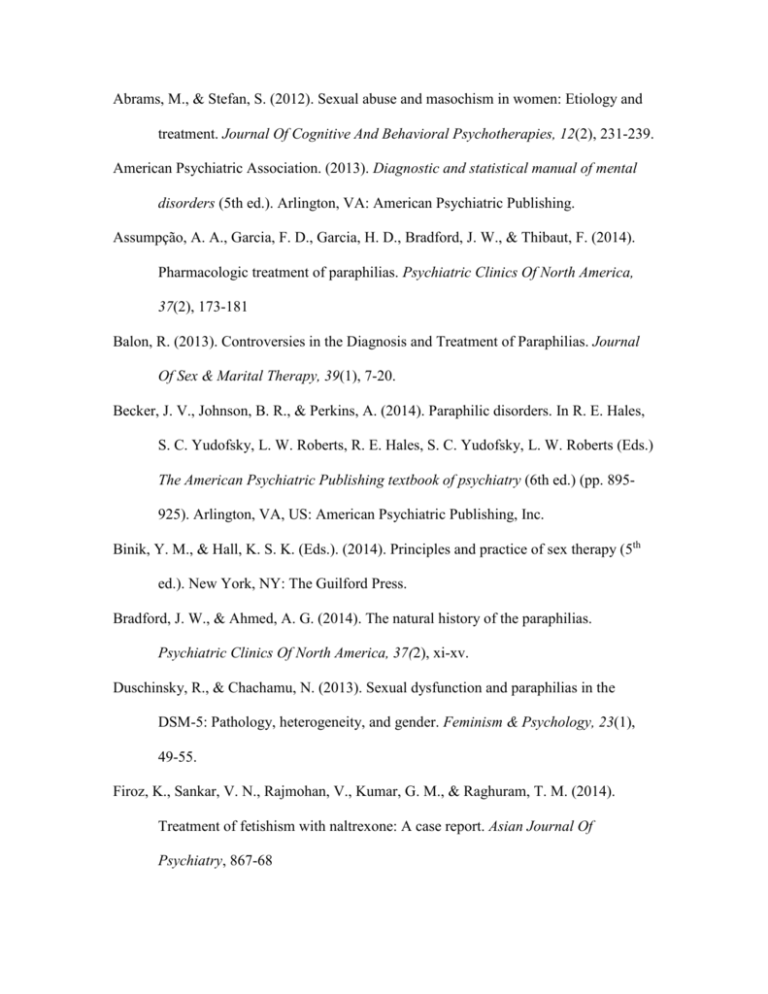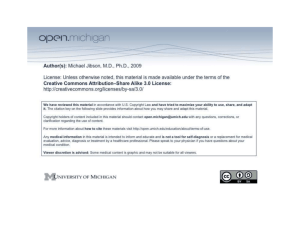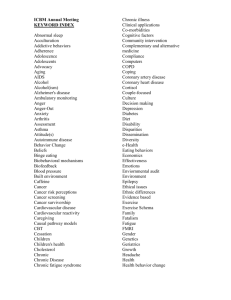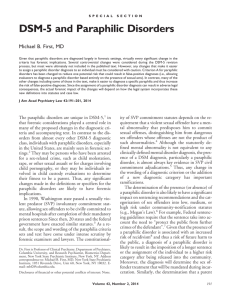
Abrams, M., & Stefan, S. (2012). Sexual abuse and masochism in women: Etiology and
treatment. Journal Of Cognitive And Behavioral Psychotherapies, 12(2), 231-239.
American Psychiatric Association. (2013). Diagnostic and statistical manual of mental
disorders (5th ed.). Arlington, VA: American Psychiatric Publishing.
Assumpção, A. A., Garcia, F. D., Garcia, H. D., Bradford, J. W., & Thibaut, F. (2014).
Pharmacologic treatment of paraphilias. Psychiatric Clinics Of North America,
37(2), 173-181
Balon, R. (2013). Controversies in the Diagnosis and Treatment of Paraphilias. Journal
Of Sex & Marital Therapy, 39(1), 7-20.
Becker, J. V., Johnson, B. R., & Perkins, A. (2014). Paraphilic disorders. In R. E. Hales,
S. C. Yudofsky, L. W. Roberts, R. E. Hales, S. C. Yudofsky, L. W. Roberts (Eds.)
The American Psychiatric Publishing textbook of psychiatry (6th ed.) (pp. 895925). Arlington, VA, US: American Psychiatric Publishing, Inc.
Binik, Y. M., & Hall, K. S. K. (Eds.). (2014). Principles and practice of sex therapy (5th
ed.). New York, NY: The Guilford Press.
Bradford, J. W., & Ahmed, A. G. (2014). The natural history of the paraphilias.
Psychiatric Clinics Of North America, 37(2), xi-xv.
Duschinsky, R., & Chachamu, N. (2013). Sexual dysfunction and paraphilias in the
DSM-5: Pathology, heterogeneity, and gender. Feminism & Psychology, 23(1),
49-55.
Firoz, K., Sankar, V. N., Rajmohan, V., Kumar, G. M., & Raghuram, T. M. (2014).
Treatment of fetishism with naltrexone: A case report. Asian Journal Of
Psychiatry, 867-68
First, M. B. (2014). DSM-5 and paraphilic disorders. Journal Of The American Academy
Of Psychiatry And The Law, 42(2), 191-201.
Fisher, A. D., & Maggi, M. (2014). Treatment of paraphilic sex offenders. In G. Corona,
E. A. Jannini, M. Maggi, G. Corona, E. A. Jannini, M. Maggi (Eds.) , Emotional,
physical and sexual abuse: Impact in children and social minorities (pp. 17-31).
Cham, Switzerland: Springer International Publishing.
Fong, T. W., De La Garza, R. I., & Newton, T. F. (2005). A Case Report of Topiramate
in the Treatment of Nonparaphilic Sexual Addiction. Journal Of Clinical
Psychopharmacology, 25(5), 512-514.
Greenberg, D. M., & Bradford, J. W. (1997). Treatment of the paraphilic disorders: A
review of the role of the selective serotonin reuptake inhibitors. Sexual Abuse:
Journal Of Research And Treatment, 9(4), 349-360.
Grubin, D. (2004). Sexual offending and treatment of sex offenders. Psychiatry 3(11),
17-21.
Guay, D. P. (2009). Drug treatment of paraphilic and nonparaphilic sexual disorders.
Clinical Therapeutics: The International Peer-Reviewed Journal Of Drug
Therapy, 31(1), 1-31.
Horley, J. (1995). Cognitive-behavioral therapy with an incarcerated exhibitionist.
International Journal Of Offender Therapy And Comparative Criminology, 39(4),
335-339
Jahnke, S., Philipp, K., & Hoyer, J. (2015). Stigmatizing attitudes towards people with
pedophilia and their malleability among psychotherapists in training. Child Abuse
& Neglect, 4093-102.
Joyal, C. C. (2014). How anomalous are paraphilic interests? Archives Of Sexual
Behavior, 43(7), 1241-1243.
Kafka, M.P. (2009). Hypersexual disorder: A proposed diagnosis for DSM-V. Archives
Of Sexual Behavior 39(), 377-400.
Kafka, M. P., & Krueger, R. B. (2011). Response to Moser’s (2010) critique of
hypersexual disorder for DSM-5. Archives Of Sexual Behavior, 40(2), 231-232.
Khodayarifard, M., Pritz, A., Alavi, S. M., & Abedini, Y. (2013). A case study of
cognitive-behavior therapy in Iran: Treatment of sexual masochism along with co
morbid disorders in a collectivist society. International Journal Of
Psychotherapy, 17(1), 53-63.
Krueger, R. B., & Kaplan, M. S. (2012). Cognitive-behavioral treatment of the
paraphilias. The Israel Journal Of Psychiatry and Related Sciences, 49(4),
291-296.
Krueger, R. B., & Kaplan, M. S. (2012). Paraphilic diagnoses in DSM-5. The Israel
Journal Of Psychiatry and Related Sciences, 49(4), 248-254.
Krueger, R. B., & Kaplan, M. S. (2010). Diagnosis, Assessment, and Treatment of
Hypersexuality. Journal of Sex Research, 47(2), 181-198.
Krueger, R. B., & Kaplan, M. S. (2002). Behavioral and psychopharmacological
treatment of the paraphilic and hypersexual disorders. Journal Of Psychiatric
Practice, 8(1), 21-32.
Krueger, R. B., & Kaplan, M. S. (2002). Peer commentaries on Green (2002) and
Schmidt (2002): A favorable view of the DSM-IV diagnosis of pedophilia and
empathy for the pedophile. Archives of Sexual Behavior, 31(6), 479-503.
Krueger, R. B., & Kaplan, M. S. (2001). The paraphilic and hypersexual disorders: An
Overview. Journal Of Psychiatric Practice, November 2001, 391-403.
Labelle, A., Bourget, D., Bradford, J.M.W., Alda, M., & Tessier, P. (2012). Familial
paraphilia: A pilot study with the construction of genograms. International
Scholarly Research Network Psychiatry
Lothstein, L. M. (1996). Antiandrogen treatment for sexual disorders: Guidelines for
establishing a standard of care. Sexual Addiction & Compulsivity, 3(4), 313-331.
Marshall, W.L. (2007). Diagnostic issues, multiple paraphilias, and comorbid disorders in
sexual offenders: their incidence and treatment. Aggression and Violent Behavior,
12 (), 16-35.
Ogunwale, A. (2012). Forensic psychiatry, DSM-V and legal insanity. African Journal Of
Psychiatry, 15(2), 91.
Poeppl, T.B., Nitschke, J., Santtila, P., Schecklmann, M., Langguth, B., Greenlee, M.W.,
Osterheider, M., & Mokros, A. (2013). Association between brain structure and
phenotypic characteristics in pedophilia. Journal of Psychiatric Research, 47,
678-685.
Saleh, F. M. (2005). Issues to Consider in the Assessment and Treatment of Paraphilic
Patients. Journal Of Clinical Psychiatry, 66(6), 802-803.
Sarver, N. W., & Gros, D. F. (2014). A modern behavioral treatment to address fetishism
and associated functional impairment. Clinical Case Studies, 13(4), 336-351.
Seto, M. C., & Ahmed, A. G. (2014). Treatment and management of child pornography
use. Psychiatric Clinics Of North America, 37(2), 207-214.
Seto, M. C., Kingston, D. A., & Bourget, D. (2014). Assessment of the paraphilias.
Psychiatric Clinics Of North America, 37(2), 149-161.
de Silva, P. (2006). Paraphilias. Psychiatry, 6(3), 130-134.
Thilbaut, F. (2011). Pharmacological treatment of sex offenders. Sexologies, 20, 166-168
Turner, D., Schöttle, D., Bradford, J., & Briken, P. (2014). Assessment methods and
management of hypersexuality and paraphilic disorders. Current Opinion In
Psychiatry, 27(6), 413-422.
Twohig, F., & Furnham, A. (1998). Lay beliefs about overcoming four sexual
paraphilias: fetishism, paedophilia, sexual sadism, and voyeurism. Personality
and Individual Differences, 24(2), 267-278.
Wakefield, J. C. (2012). The DSM-5’s proposed new categories of sexual disorder: The
problem of false positives in sexual diagnosis. Clinical Social Work Journal,
40(2), 213-223.
Wakefield, J. C. (2011). DSM-5 proposed diagnostic criteria for sexual paraphilias:
Tensions between diagnostic validity and forensic utility. International Journal
Of Law And Psychiatry, 34(3), 195-209.
Walter, M., Witzel, J., Wiebking, C., Gubka, U., Rotte, M., Schiltz, K., Bermpohl, F.,
Tempelmann, C., Bogerts, B., Heinze, H.J., & Northoff, G. (2007). Pedophilia is
linked to reduced activation in hypothalamus and lateral prefrontal cortex during
visual erotic stimulation. Biological Psychiatry, 62. 698-701.
Widerman, M. W. (2003). Paraphilia and fetishism. The Family Journal, 11, 315-323.
Wright, S. (2014). Kinky parents and child custody: The effect of the DSM-5
differentiation between the paraphilias and paraphilic disorders. Archives Of
Sexual Behavior, 43(7), 1257-1258.
Wright, S. (2010). Depathologizing consensual sexual sadism, sexual masochism,
transvestic fetishism, and fetishism. Archives Of Sexual Behavior, 39(6), 12291230.









